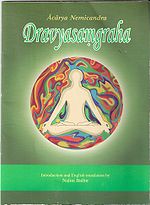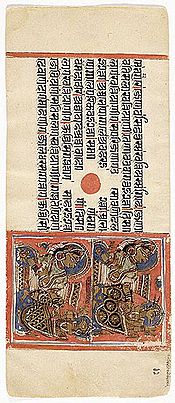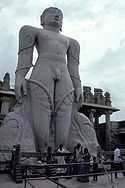- Dravyasamgraha
-
Dravyasamgraha 
Author(s) Nemicandra Translator Nalini Balbir Country India Language Prakrit Genre(s) Jain text Publisher Hindi Granth Karyalay Publication date 10th Century ISBN 978-81-88769-30-8 Dravyasaṃgraha (Devnagari: द्रव्यसंग्रह) (Compendium of substances) is a 10th century Jain text in Jain Sauraseni Prakrit by Acarya Nemicandra belonging to the Jain Digambara tradition. It is a composition of 58 gathas (verses) giving an exposition of the six dravyas (substances) that characterize the Jain view of the world: sentient (jīva), non-sentient (pudgala), principle of motion (dharma), principle of rest (adharma), space (ākāśa) and time (kāla).[1] It is one of the most important Jain works and has gained widespread popularity. Dravyasaṃgraha has played an important role in Jain education and is often memorized because of its comprehensiveness as well as brevity.[1]
Contents
Author
Main article: NemichandraDravyasaṃgraha is composed by the 10th century Jain Acarya, Nemicandra Siddhānta Cakravartin. He was a contemporary of Camundaraya—the general of the Western Ganga Dynasty of Karnataka—who was also his disciple. Nemicandra was a prolific author and a specialist in summarizing and giving lucidly the essence of teachings in various fields; saṃgrahas (compendium) and sāras (essence) were his specialty. He also wrote Trilokasāra (essence of cosmology), Labdhisāra (essence of attainments), Kṣapaṇasāra (essence on destruction of karmas), and Gommaṭasāra (essence of Gommata, a treatise on soul and Karma).[1] Although not much is known about him from his own works, at the end of the Trilokasāra and of the Gommaṭasāra, he introduces himself as a pupil of Abhayanandi, Vīranandi, Indranandi and Kanakanandi. He is said to have inspired Camundaraya to build the famous Bāhubali statue at Shravanabelagola. Vahuvali Charitra (a Jain work based on collection of traditions) notes that Nemicandra belonged to the monastic order of Desiya gana. After establishing the statue of Bāhubali, Camundaraya offered villages yielding a revenue of 96,000 gold coins to Nemicandra for daily worship of and festivals for Gommatesvara (Lord Bāhubali).[2]
Influence
Dravyasaṃgraha has played an important role in Jain education and is often memorized because of its comprehensiveness and brevity.[1] The composition of Dravyasaṃgraha is influenced from the earlier Jain works such as Umāsvāti’s Tattvārthasūtra and Kundakunda's Pañcāstikāyasara because these works are based on the same topics as the Dravyasaṃgraha.[3]
Contents and overview
According to Nalini Balbir, the Dravyasaṃgraha is largely a work of definitions of concepts with mnemonic perspective. In its 58 verses, the author makes skillful use of āryā metre.[3] Nemicandra’s presentation is often articulated around the opposition between the conventional and the absolute points of view (vyavahāra and niścaya-naya), or around the contrast between the material and the spiritual angles (dravya and bhāva). Sarat Chandra Ghoshal, the translator of Dravyasaṃgraha, divides the entire text in three convenient parts—the first part deals with six dravyas (verses 1–27), the second with seven tattvas (verses 28–39) and the third part describes the way to attain liberation (verses 40–57).[4]
The six dravyas
Main article: Dravya (Jainism)In tine opening verse, along with the usual mangalacharana (eulogy), it is mentioned that dravya consists of jiva and ajiva. In the second verse Jiva is defined:[5]
The sentient substance (soul) is characterized by the function of understanding, is incorporeal, performs actions (doer), is co-extensive with its own body. It is the enjoyer (of its actions), located in the world of rebirth (samsara) (or) emancipated (moksa) (and) has the intrinsic movement upwards.— Dravyasamgraha—2The various characteristics of Jiva mentioned in the definition are taken up one by one in verses 3–14. Dravyasaṃgraha classifies the embodied souls on the basis of the number of senses possessed by it: from one to five senses.[6] After this detailed description of Jivas the author proceeds to describe Ajivas—Pudgala, Dharma, adharma, Akasa and Kala, each of which is defined in verses 16–22. Among these, as per verse 23, the Jiva, pudgala, dharma, adharma, and akasa are called astikayas, the extensibles or conglomerates.[4]
Tattvas
Main article: Tattva (Jainism)The second part deals with the seven tattvas (fundamental principles or verities): jīva (soul), ajīva (non soul), āsrava (karmic inflow), bandha (bondage of karmas), saṃvara (stoppage of karmas), nirjarā (shedding of karmas) and mokṣa (emancipation or liberation). Together with puṇya (merit or beneficial karma) and pāpa (demerit or harmful karma) they form nine padartha. Some call all nine as navatattava or nine tattvas.[4]
Moksa
Main article: Moksa (Jainism)The third part of Dravyasaṃgraha begins with verse 39 describing the means to attain liberation from conventional and real point of views. The three jewels of Jainism also known as Ratnatraya—Samyak darśana (rational perception), samyak jñāna (rational knowledge) and samyak cāritra (rational conduct)—which are essential in achieving liberation—are defined[7][8] and the importance of dhayana (meditation) is emphasized. On meditation, Nemicandra says:[9]
Do not be deluded, do not be attached, do not feel aversion for things which are (respectively) dear or not dear (to you), if you desire a steady mind for the attainment of extraordinary meditation.— Dravyasamgraha—48Do not act, do not talk, do not think at all, so that the soul is steady and is content in the self. This indeed is supreme meditation.—Dravyasamgraha—56Verses 49 to 54 discusses the five classes of supreme beings and their characteristics.[10]
Commentaries
One of the most popular commentaries of Dravyasaṃgraha is that by Brahmadeva from around the 14th century. Other commentaries on the work include:[11]
- Balacandra (1142) – Tika on Nemicandra's Dravyasamgraha
- Mallisena (1292) – Commentary on Nemicandra Siddhantin's Dravyasamgraha
- Brahmadeva (1300) – Vrtti on Nemicandra's Dravyasamgraha
- Hamsaraja (1750) – Commentary on Nemicandra's Dravyasamgraha.
- Ramacandra – Commentary on Nemicandra's Dravyasamgraha.
See also
References
Notes
- ^ a b c d Acarya Nemicandra; Nalini Balbir (2010) p. 1 of Introduction
- ^ Nemicandra; Brahmadeva, & Ghoshal, Sarat Chandra (1989) pg. xxxviii of introduction
- ^ a b Acarya Nemicandra; Nalini Balbir (2010) p. 2 of Introduction
- ^ a b c Nemicandra; Brahmadeva, & Ghoshal, Sarat Chandra (1989) pg. xlv of introduction
- ^ Acarya Nemicandra; Nalini Balbir (2010) p. 4
- ^ Nemicandra; Brahmadeva, & Ghoshal, Sarat Chandra (1989) p.31-32
- ^ Nemicandra; Brahmadeva, & Ghoshal, Sarat Chandra (1989) p. 101
- ^ Acarya Nemicandra; Nalini Balbir (2010) p. 20
- ^ Acarya Nemicandra; Nalini Balbir (2010) p. 22
- ^ Nemicandra; Brahmadeva, & Ghoshal, Sarat Chandra (1989) pg. xlv- xlvi of introduction
- ^ Potter, Prof. Karl. "Bibliography of Indian Philosophies:10th c. – 14th c. & 15th c. – present (Texts whose authors can be dated)". The Encyclopedia of Indian Philosophies. University of Washington. http://faculty.washington.edu/kpotter/ckeyt/home.htm. Retrieved 2010-14-01.
Bibliography
- Acarya Nemicandra; Brahmadeva, & Ghoshal, Sarat Chandra (1989) (in English translation with Prakrit gāthās (text) and Sanskrit chhāyās (renderings) and padapāṭha). Dravya-saṃgraha of Nemichandra Siddhānta-Chakravarttī. Delhi: Motilal Banarsidass Publ. ISBN 8120806344.
- Nemicandra; Nalini Balbir (2010) (in Prakrit and English). Dravyasamgrha: Exposition of the Six Substances. Pandit Nathuram Premi Research Series (vol-19). Mumbai: Hindi Granth Karyalay. ISBN 978-81-88769-30-8.
Śvetāmbara (Canonical Texts)
Angāgama Ācāranga sūtra • Sūtrakrtanga • Sthānānga • Samavāyānga • Vyākhyāprajñapti or Bhagavati sūtra • Jnātrdhārmakathāh • Upāsakadaśāh • Antakrddaaśāh • Anuttaraupapātikadaśāh • Praśnavyākaranani • Vipākaśruta • Drstivāda (Now Extinct)Upanga āgamas Aupapātika • Rājapraśnīya • Jīvājīvābhigama • Prajñāpana • Sūryaprajñapti • Jambūdvīpaprajñapti • Candraprajñapti • Nirayārvalī • Kalpāvatamsikāh • Puspikāh • Puspacūlikāh • VrasnidaśāhChedasūtra Ācāradaśāh • Brhatkalpa • Vyavahāra • Niśītha • Mahāniśītha • JītakalpaMūlasūtra Daśavaikālika • Uttarādhyayana • Āvaśyaka • PindaniryukytiPrakīrnaka sūtra Catuhśarana • Āturapratyākhyanā • Bhaktaparijñā • Samstāraka • Tandulavaicarika • Candravedhyāka • Devendrastava • Ganividyā • Mahāpratyākhyanā • VīrastavaCūlikasūtra Nandī-sūtra • Anuyogadvāra-sūtraDigambara TextsĀgamas Satkhandāgama • KasāyaprabhrtaPratham -ānuyoga Padmapurāna • Harivamsapurāna • Ādipurāna • UttarapurānaCarnānuyoga Mulācāra • Trivarnācāra • Ratnakaranda śrāvakācāraGanitānuyoga Sūryaprajñapti • Candraprajñapt • Jayadhavalātikā • GommatasāraDravyānuyoga Commentary Commentary on Tattvarthasūtra and AptmimamsaTattvārthasūtra is accepted by both Digambaras and Śvetāmbara as their texts although Śvetāmbaras do not include it under canonical texts.Categories:- Jain texts
Wikimedia Foundation. 2010.

